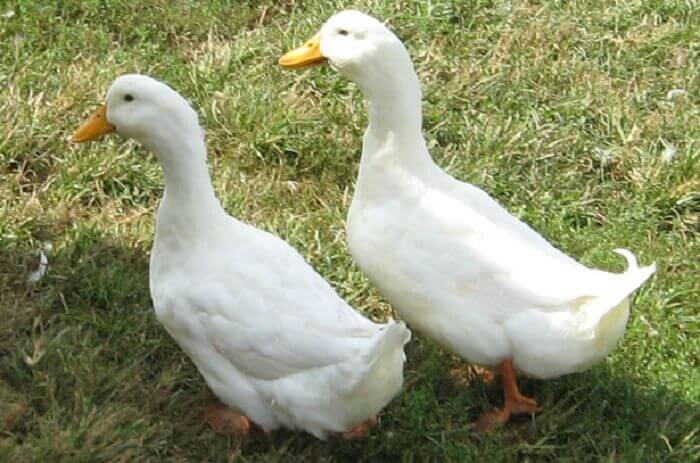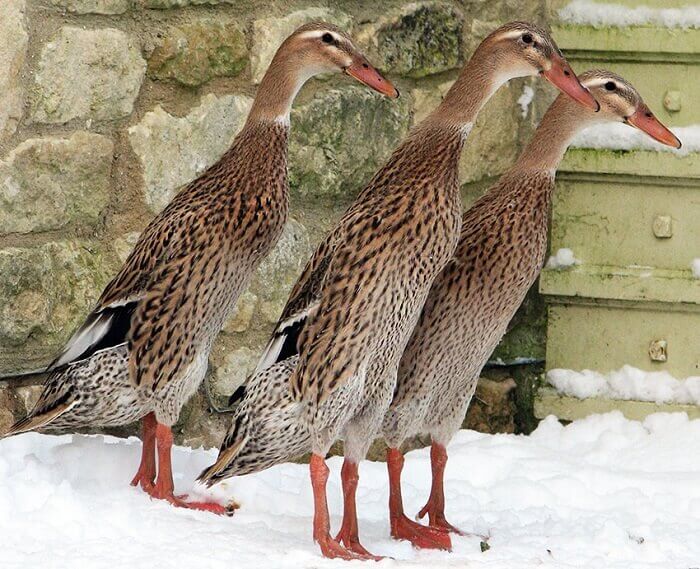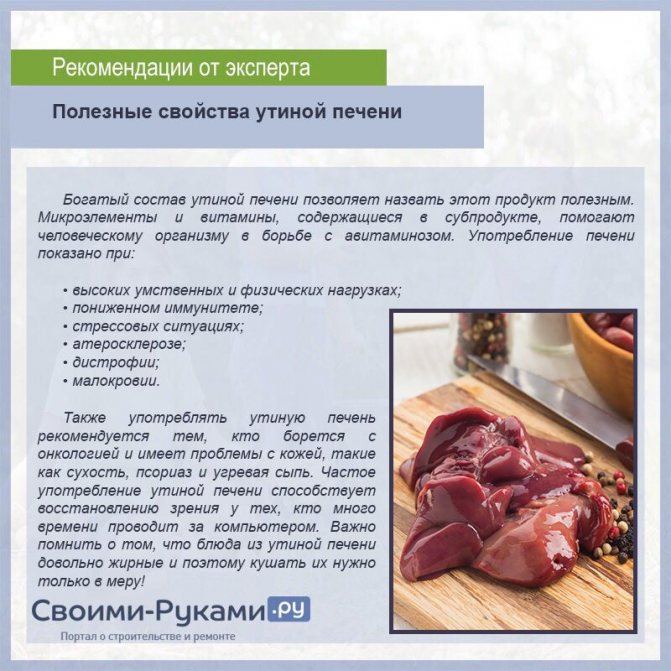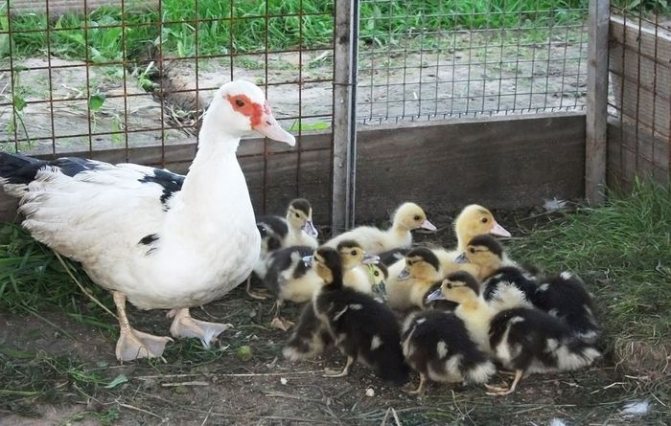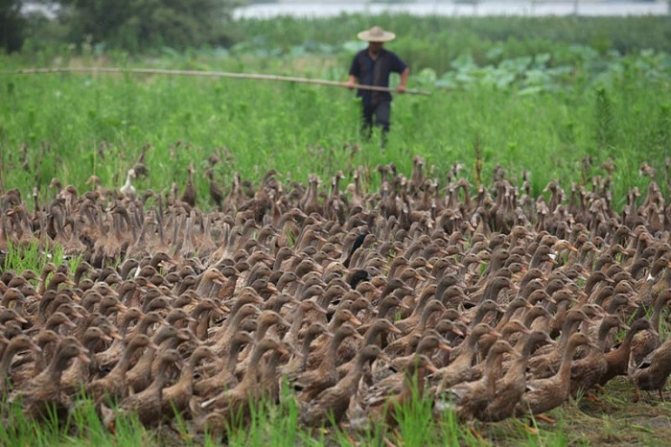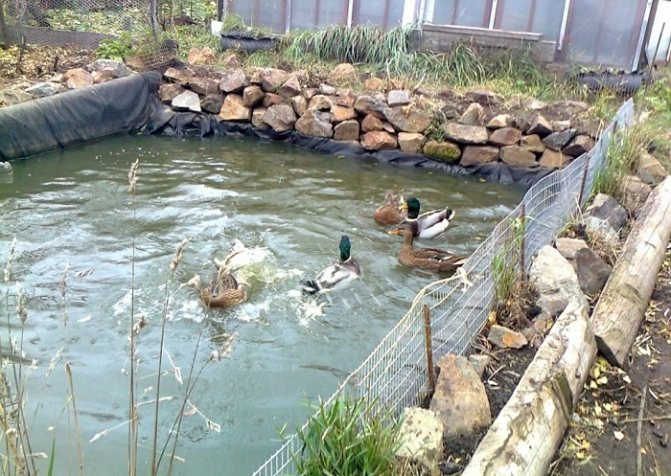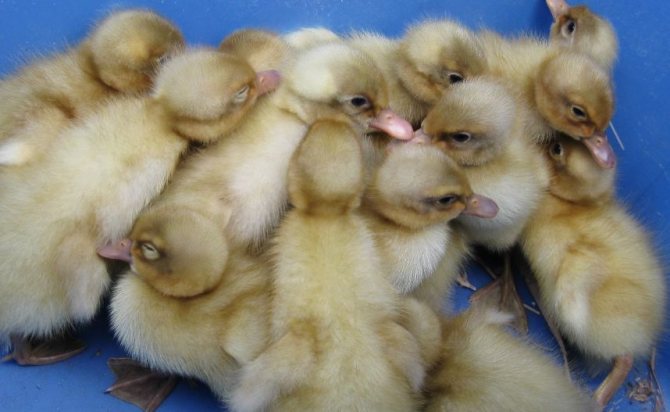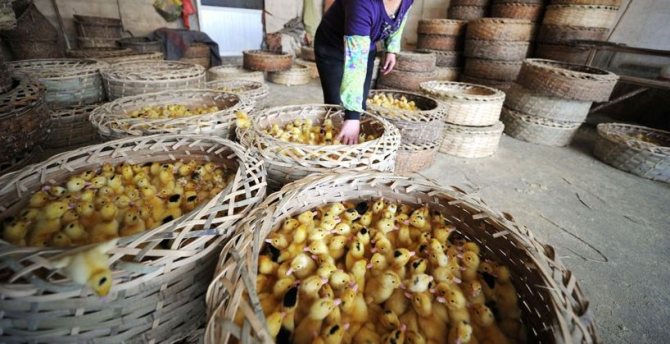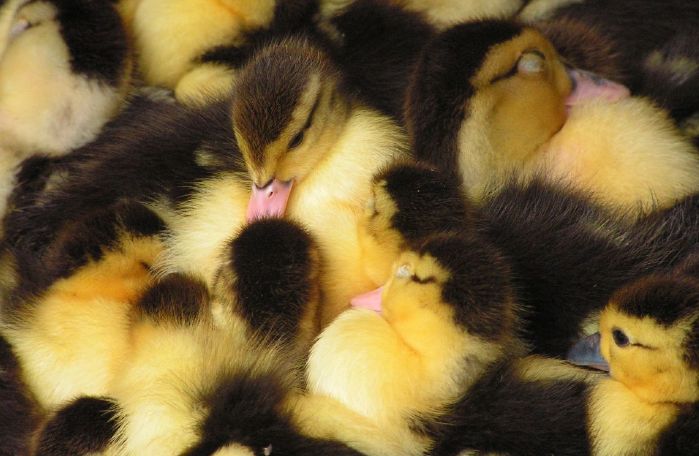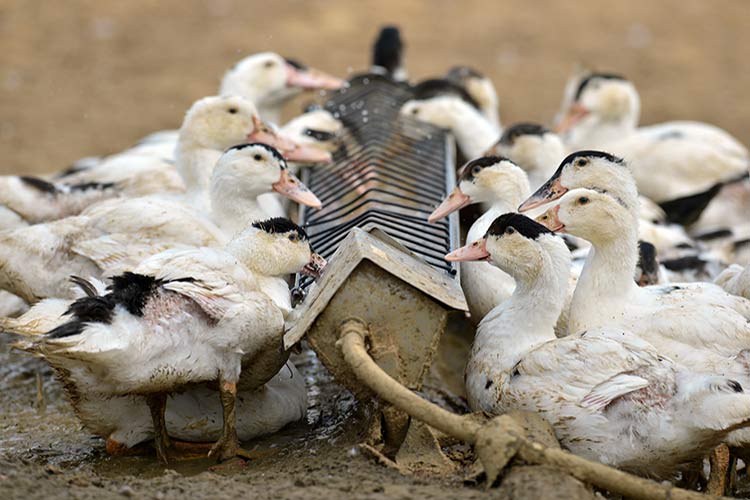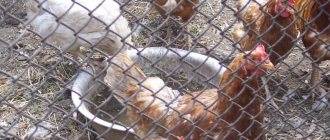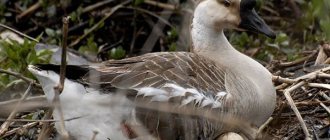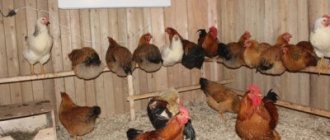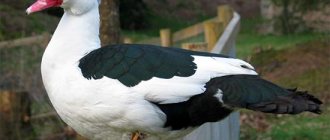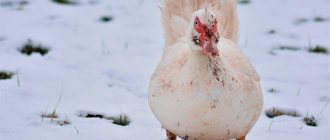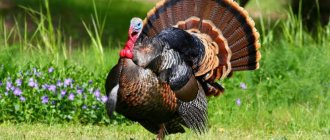Poultry »Ducks
0
1552
Article rating
Domestic ducks are unpretentious birds, from which you can get a lot of meat, and sometimes eggs, so many site owners try to breed these waterfowl in their backyard. But in order for the hatching to be successful, it is necessary to take into account a number of important points. You need to know how ducklings are raised at home, how housing is made for birds, how to feed ducks. It is also worth immediately deciding which breed will need to be bred in your area.
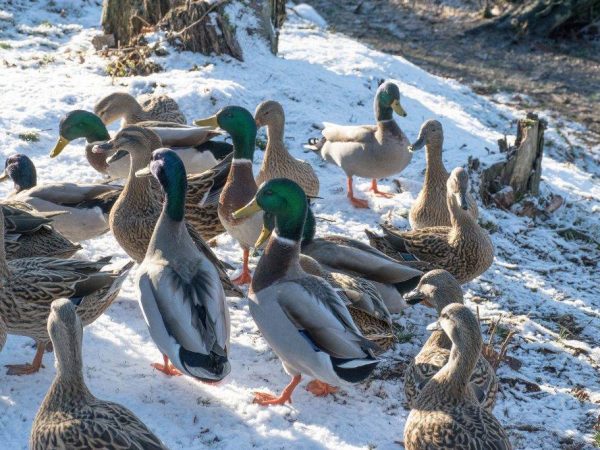
Breeding ducks at home
Beijing
The presented breed is one of the most productive in terms of meat ducks. China is considered its homeland, and it was bred about 300 years ago. But already 100 years after its inception, the breed has gained wide popularity throughout the world.
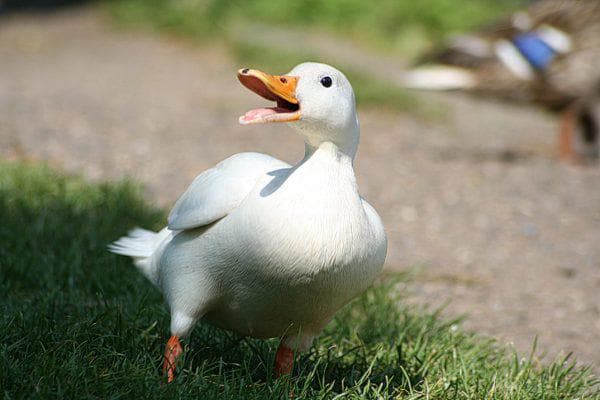

Beijing
The main characteristics of the Peking duck can be considered:
- Big sizes. Peking ducks are quite large, and their breasts are set wide.
- The female weighs up to 3.5 kg, and the drake - 4 kg.
- A female Peking breed is capable of producing 120 eggs per year. The mass of one is 95 g.
- The breed is characterized by an accelerated metabolism.
- Not picky about food, as it belongs to omnivores.
- The plumage is white, the beak is yellow, and the limbs are red.
The positive characteristics of the Peking duck include:
- Widely known all over the world.
- It doesn't take long for the duck to be ready to fertilize and lay eggs.
- The breed is not afraid of winter cold and quickly adapts to various climatic conditions.
- Long lifespan and negligible care.
- Peking birds, like the Agidel breed of ducks, are resistant to diseases, as they have good health.
The representatives of the Peking breed have their own disadvantages:
- The bird is loud. If you start such a farm, then you need to be prepared for the fact that it will not be quiet in the yard. There is always some kind of host goose who will provoke the rest of the birds into a conflict.
- For maximum performance, ducks should be well cared for and nourished. And here you can find out more about the cultivation of Peking duck.
Chicks gain weight 2-3 kg after a couple of months. This is an excellent indicator for ducks. But you don't need to raise ducks after molting. This time is great for slaughtering, as the weight limits have already been reached. In addition, during this period, the bird requires more feed and food additives. Thus, its content becomes irrational.
Raising ducklings
What are the reasons for such a phenomenon as the death of young duck on the paws, how to carry out timely treatment and take preventive measures, find out from us
Mulard is a breed of ducks that is not capable of producing offspring. These birds are bred to obtain quality meat. How to feed mulard ducklings, read the article
How to feed monthly ducklings? Each farmer has his own method of feeding the young. Read about the organization of nutrition for the offspring of a duck in the first stages of life.
It is important to know how to feed weekly ducklings, since at this age the birds are still weak, and improperly selected food can harm them. Read more with us
Despite the fact that Indo-ducklings are almost omnivorous, certain conditions and rules must be observed when feeding ducklings.What - read in the article
Self-preparation of feed guarantees not only confidence in quality products, but also significant savings. So how do you make your own food?
Ducks eat food quite quickly, scattering and trampling it. You can eradicate this problem and save food by making do-it-yourself feeders for ducklings.
There are many instructions for making different types of drinkers for ducklings and adult ducks. How to make drinking bowls for ducklings with your own hands, learn from the article
The issue of feeding young animals is one of the main issues in raising livestock. Properly organized feeding of ducklings is the key to the growth of a healthy and strong herd
All poultry farmers have their own method of feeding ducklings. We have summarized dietary advice for domestic duck chicks in the first days and weeks of life. Read the article!
If you decide to buy and raise Indo-Ducks, then you should know how to feed Indo-Ducks so that they grow at the right speed. Read the article about this.
It is not difficult to start your own livestock, it is more difficult to deal with the issues of keeping ducklings, since young animals at this age require special attention.
The procedure for hatching ducklings in an incubator is simple, the main thing is to follow the regime, feed the hen correctly, and provide her with care in order to get high-quality eggs.
For ducklings, vitamins are vital, without them you will not be able to properly feed them for meat and get enough eggs. So what do ducklings need?
Raising ducklings is not troublesome and profitable. Ducks spend a lot of time on free grazing or water bodies, so they do not need to create special conditions
Growing ducks at home: maintenance and care
Keeping ducks at home for beginners is not much different from raising chickens or geese. However, there are some nuances that should be considered when breeding this bird. You should definitely dwell on them in more detail. Including how long ducks live.
An interesting point is that duck eggs can be placed under a chicken or turkey, and they will hatch eggs, mistaking them for their own. But a duck or goose is unlikely to want to do the same with other people's eggs. So, any of the three poultry is chosen as a brood hen - chicken, duck or turkey. Of course, it is better if it is a duck.
Up to 15 eggs are usually placed under the duck if the brood is planned to be obtained in the summer and up to 12 if in the spring. This is due to the ambient temperature. Naturally, more eggs are placed under the turkey, which is explained by its large size, and less under the chicken. The main thing is that all eggs in the clutch are under the hen in order to evenly heat them by the body of the hen.
For the hen, a wreath-shaped nest is made of straw so that the eggs do not roll in different directions. The hen will add the rest of the components (for example, feathers). On the bottom of the nest, if it is located on the floor, put sawdust and chaff.
Raising ducklings with a brood hen
It is best to make the nest on a small hill and away from direct sunlight, in the darkest part of the house. There is no need to artificially shade this place. If it seems uncomfortable to you, make an impromptu partition. This will separate one nest from the other and create a feeling of extra comfort. The first brood is received as early as 27 days after the start of incubation.
All chicks should hatch in 1 to 2 days. So that the hen does not hush them up, the ducklings are taken to a separate box immediately after birth. To do this, you can take a cardboard box lined with straw and a floor. The normal temperature for them at this time is 30 degrees. Therefore, if the brood turned out in spring, take care of an additional source of heat.
Keep the box, crate or basket where the ducklings are kept dry.
After all the ducklings are born, they are returned to the hen - the duck. Better to do this in the evening. Make sure that the mother duck accepts them, as chicks especially need warmth during this period.
The main advantage of raising ducklings in an incubator is the ability to get a brood at any time convenient for you. In addition, there is no need to take care of the hen, and the incubator can be made with your own hands. Modern home incubators are equipped with temperature and humidity controls. Therefore, you just have to monitor the process, turn the eggs over (if this is not automatically provided for by the incubator design) and occasionally open the apparatus for their small short-term cooling and to remove accumulated gases.
Before laying, the incubator is heated, setting the temperature 1-2 degrees higher than necessary for incubating eggs at the very beginning of the process. In addition, it is recommended to increase the humidity of the air. For this, several trays of water are installed on the pallet.
Due to the fact that the shell of duck eggs is stronger than chicken and they are larger in size, somewhat different in chemical composition, the brood appears later.
Duck eggs need more care than chicken eggs and require high humidity for themselves.
In the first week after laying, the temperature in the incubator should be at 38 degrees (the first 3 days - 38.2, the next 4 - 37.8). Humidity is required to be kept at 60%. After two weeks of eggs in the incubator, it is worth opening the incubator door for 30 minutes twice a day, reducing the temperature to 32 degrees. Then the temperature regime is resumed.
Grown incubator ducks in the paddock
If you have an ovoscope, you need to check the eggs for embryos after 9-10 days. A sharp drop in air temperature must not be allowed. Chicks hatch on the 27-28th day within one or two days. Air humidity is maintained at 55%. After the chicks are dry, they are transferred to a box, basket, box, after putting dry sawdust, chaff, and straw on the bottom.
Install an additional heating source so that the ambient temperature at the litter level does not fall below 28 degrees and the air humidity up to 80%.
In the first 20 days of life, ducklings need increased attention in relation to compliance with the temperature regime. If they are near the duck, you should not worry about an additional source of heating - the duck itself is able to protect them from low temperatures. In the first week of life, the temperature should be maintained at the litter level of 27-30 degrees;
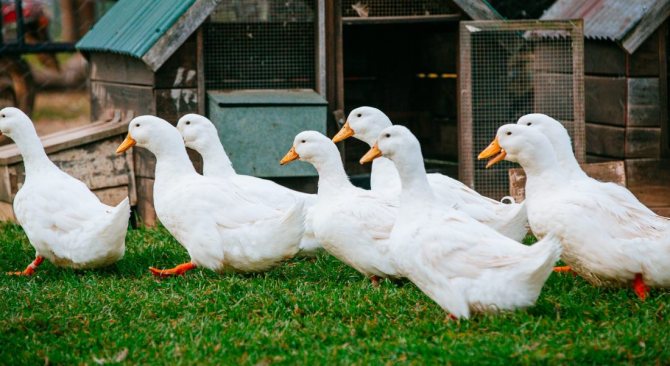

The duration of daylight hours at the beginning of life should be at the level of 20 hours with a gradual decrease to 12 hours at the age of one month.
Ducklings with a duck in the morning and afternoon are allowed to walk after five days of age. In the evening, they are closed in a room with additional heating, if the air temperature is below the above marks. And after three weeks of age, you can even leave them outside the room around the clock.
The presence of a reservoir is very good for raising ducklings. With an adult bird, they are released into the water after three weeks of life. Independently - after a month. You can keep ducklings in cages for the first two weeks. Then they are given more freedom. That is, partly walking. Monthly young growth is transferred entirely to the content of the walk.
Duck keeping. Ducks outdoors behind a hedge
Feeding ducklings at home for beginners is simple. Youngsters quickly get used to receiving food at the same time. Therefore, you do not have to teach them in addition to a specific diet. Ducklings grow and gain weight quickly. At three weeks of age, he weighs about half a kilogram, after six weeks his weight is on average one and a half kilograms, and at 2.5 months he can already be slaughtered, since his weight reaches two and a half kilograms.
But it is better to slaughter them before the onset of frost, since in summer and autumn the main diet of ducks is greens and everything that they themselves find on the reservoir. That is, you have to spend little on food.
You may also be interested in useful articles:
- All about incubating duck eggs at home.
- How to raise broiler ducks at home.
- How to breed Peking ducks on your farm.
- Description, characteristics and advantages of Agidel ducks.
Feeding ducks at home in the first week occurs 6-8 times during the day. A schedule can be made so that the first feed is early in the morning and the last feed before dusk. Finely crumbled boiled eggs, low-fat cottage cheese, and other milk-based products are the main diet of ducklings during this period.
The fact is that a duck is a waterfowl. At a very young age, she manifests an instinct to eat food, either in water, or to drink it directly after it enters the beak. Thus, if you put the drinker away from food, the duckling, until it reaches the drinker after eating, will already swallow the bulk of it.
After five days, they begin to prepare mash for ducklings from the above products with the addition of ground corn and wheat skins.
As always, care must be taken to keep the water in the drinkers fresh and clean. This is important because dirty and stagnant water carries many diseases.
How to feed small ducks at home? After a week of life, the ducklings are accustomed to greens, because in the future it will become the main food in the diet of these birds. At this age, the duckling eats about 40 grams of various foods. Gradually reduces the proportion of boiled eggs and dairy products, replacing them with large portions of wheat and corn skins. The diet is supplemented with animal feed: fish and meat and bone meal.
By the age of two weeks, the duckling needs about 60 grams per head. By this period, boiled eggs, cottage cheese and other dairy products are completely excluded from the diet. More greenery is given instead. Ideally, if it is duckweed. This bird eats it with pleasure in almost unlimited quantities. At the same time, intensive growth and mass gain begins.
It should not be forgotten that a growing duck eats significantly less. After 20 days of age, the ducklings are released into the pond together with the mother duck.
You can use "dry" feeding, in which the main diet will be purchased compound feed for ducklings. In this case, growing them will be more expensive, but ducklings grow faster.
The mash is cooked just before feeding the birds, as wet pre-cooked food will turn sour quickly.
How to feed ducks at home in a month? Grinding of various grain crops, millet, meat and bone and fish meal, shells, chalk, sunflower meal, fodder yeast and greens - these are the components that make up the diet of young animals during this period of life.
In addition, grazing them on a pond will diversify food and reduce the cost of maintenance by about 2 times. The total part of the grass in the diet is 40%, greens - 30%. If a duck has the ability to eat duckweed, then the component of greens in the diet increases by one and a half times.
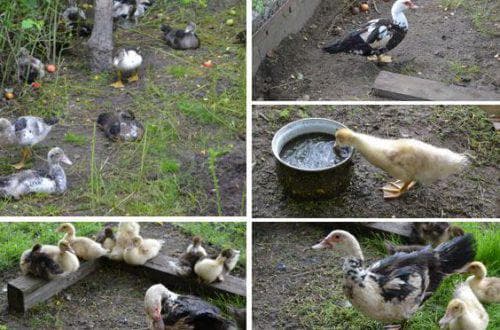

Adult duck looking for food
The minimum size of the room must comply with the rule - 3 individuals per 1 square meter. A smaller area will negatively affect the birds - they need space for a comfortable existence.
The optimal height of the house from the entrance is up to 2 meters, from the rear side - up to 1 meter. Ducks do not need a roost, so they do not need a room that is too high. You also need to make a hole on the south side measuring 35 * 45 cm for the drakes to go out on their own.
Duck Business Benefits
There are a number of benefits to the duck business. In many countries, ducks are bred along with chickens for meat and eggs.You can easily organize your duck farm, as the construction costs will be minimal, because ducks are not whimsical to care for and are not afraid of cold weather. You can also combine breeding ducks with other poultry, this bird gets along well in the courtyard with other waterfowl, for example, with geese, or with the same hens, turkeys and other representatives of birds. Some of the advantages of building your own farm based on a duck are outlined below:


- Ducks do not need to build expensive farming complexes, which means that the cost of building housing for this bird is relatively low when compared to turkey farms, for example. You can confidently build low-cost housing for ducks to start your business.
- Ducks are quite hardy birds with strong immunity and excellent acclimatization abilities. They feel great in almost any conditions of an acceptable content for a duck.
- Ducks often lay, so you can enjoy fresh eggs every day. You can calmly go about your business or devote time to caring for other animals in your farm, while the ducks swim peacefully or walk for a walk, this is understandable by the calm and unpretentious nature of the bird.
- To breed ducks, you do not need to build huge poultry houses, since one square meter indoors will be enough for three ducks.
- Ducks have a short period of incubation of eggs, and ducklings grow quickly, the main thing is to provide them with optimal conditions of detention, without temperature extremes and high humidity. And in cold weather, young livestock, before the start of plumage, must be kept in heated rooms.
- Ducks are highly resistant to various avian diseases.
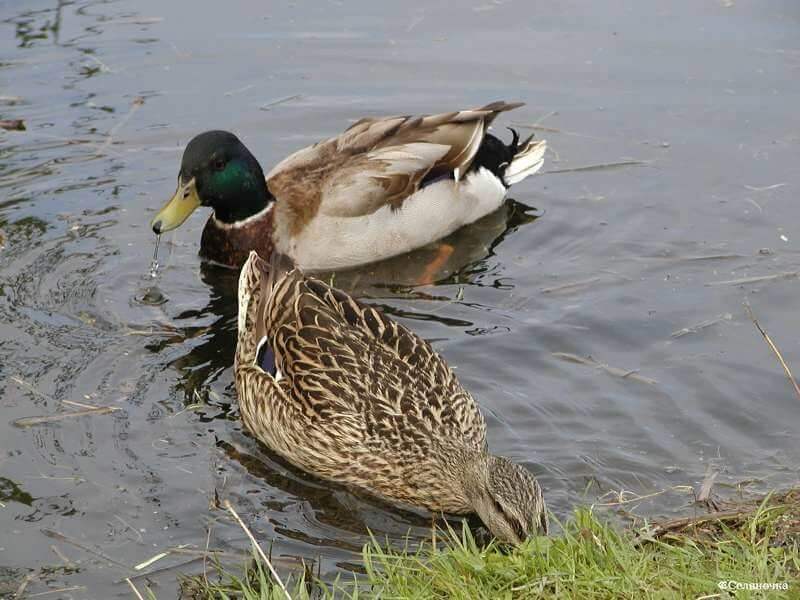

- As already mentioned, the duck is not whimsical to care for, therefore, the livestock of this bird perfectly feeds on any solid grain feed: wheat, barley, crushed corn, boiled and steamed cereals, other low-cost cereals can also diversify their diet, and it is also useful food left over from your cooking, such as peeling vegetables that can be boiled, root vegetables, and herbs. If your ducks have access to a reservoir, then their diet will diversify by itself, the fact is that ducks have some peculiarity in the wild, to get food for themselves. The duck is able to extract insects, algae, earthworms, snails and even frogs from the water, which, of course, will greatly facilitate bird care and reduce the cost of feeding.
- Ducks can also be used to clean your garden from certain types of insects and larvae, since ducks are not lovers of greenery from the beds, they can be safely allowed to work, catching caterpillars and slugs on your site.
- Ducks differ from chickens in low mortality and higher life expectancy, and ducks also fly for a long period of time.
- Duck meat, offal, down and eggs are in great demand in the domestic and foreign markets. Thus, the commercial component of duck farming is undoubtedly profitable and can be a great way for you to make money. There are many farmers who made a fortune in the duck business, and to this day, profit from their successful entrepreneurial activities.
- Setting up your own duck farm can later become a fairly stable source of employment in the countryside, unemployed people and young people who want to earn money on their own will be an excellent option for your farm. Thus, you will not only provide your own income, but also help in the fight against unemployment.
Black white-breasted
This breed is the result of crossing two species of birds - Peking and Khaki Campbell. The features of these ducks are:
- The sternum is blunt, the body is slightly raised.
- The elongated back is directed slightly upward towards the tail, and the tail originates slightly higher than it should be.
- The main color of birds is considered black, but there are white blotches in front and on the crest.
- The limbs are black, small in size.
- The beak is medium, slightly concave inward.
- the holes are pronounced, large and bright black in color.
- The wings are large, close to the body.
- Females gain weight up to 3.5 kg, and drakes - up to 4 kg. Female gives 100-130 eggs per year. Their shells can be gray or white.
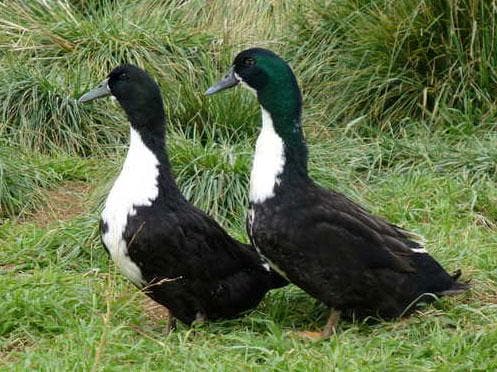

Black white-breasted
The advantages of Ukrainian birds can be considered:
- A bright representative of the meat direction.
- The duck quickly matures for sexual activity - six months after birth.
- Birds are gaining weight quickly.
- Duck meat is a delicious and healthy delicacy, just like eggs.
- Disease resistance.
Raising ducklings for a tribe
It is best to leave ducklings for the tribe, which were bred at the earliest dates (early April - late May). Such a bird will get stronger by winter and will calmly endure it. The strongest individuals should be selected, without external defects, with a good mass for their age. The plumage should be dense and soft. Secondary sexual characteristics should be pronounced.
Ducklings should be selected for the tribe twice. Select for the first time within 2-5 days after birth, and then select from these ducklings again at the age of 2 months.
Raising ducklings per breeding, in the first 3 weeks, should be the same as raising other ducklings. However, after this period, they can be released for free range, which will have a great effect on their development.
Mulard
This breed is also the result of crossbreeding. She is of French origin, belongs to the representatives of the meat direction. Her meat is distinguished by good taste, but the breed is not adapted to the laying of eggs.
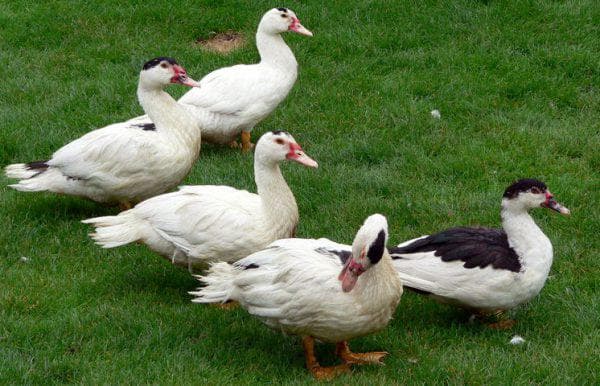

Mulard
Interesting is the fact that muland bird liver has become widespread in cooking for the preparation of foie gras. The breed is suitable for raising birds at home or in poultry farms. For those who want to learn more about growing Mularda duck, you should follow the link.
The purpose of growing poultry
As you know, there are several answers to the question about the purpose of raising ducks. The first assumes that the farmer is raising ducks for meat. The second indicates that the main task is to obtain healthy offspring with a high level of productivity, which in the future promises a large number of eggs, possibly offspring.
Also, some ornamental species are grown exclusively for beauty, and then the main purpose of cultivation will be to preserve the beauty and health of individuals. Depending on the purpose of the poultry raising, the strategy of care, rearing and nutrition will differ.
If you are going to raise ducklings at home in large numbers, then you should take into account the period when chicks are born - from late July to early September. Knowing this, you can divide breeding into three periods: the first of them (from April to June) involves breeding chicks for meat, as well as for breeding. The same can be said for the period from July to September. But the third, September offspring, there is no point in saving for breeding - it is reasonable to slaughter these birds for meat by winter.
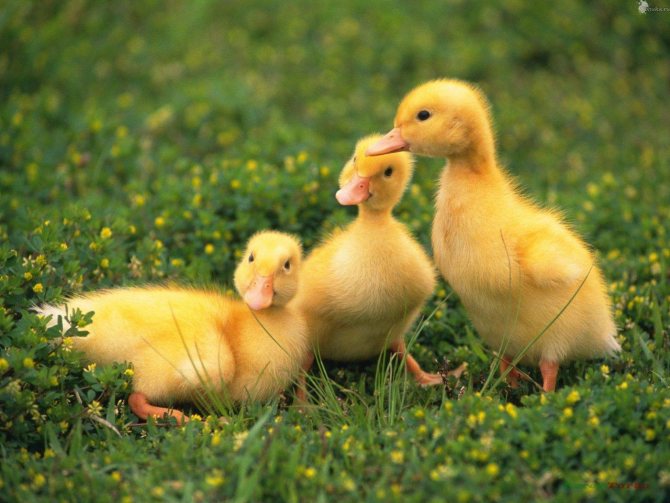

Conditions for keeping ducklings
Having gotten young ducklings, they can still be kept in a box for the first 4 days. At the same time, there should not be more than 16 chicks per square meter. On the fifth day, the birds can be transplanted into a cage or even moved to live indoors.
Make sure that all this time the temperature does not fall below 20 degrees Celsius, there are no drafts in the room. The humidity level should be low. At first, it is important to prevent the appearance of weak and lagging individuals - moved away from the feeder, thrown by other chicks from warm places. The development of such ducklings slows down, which will subsequently become too noticeable and inappropriate.
Ideally, for the first week, the chicks should live at a temperature of 26 to 30 degrees, then you can lower it to an interval of 18-25, and after the second week of life, the chicks can be moved to a room with a temperature of 16-20 degrees. Indoor temperature is very important for raising healthy birds. High temperatures reduce resistance to pathogenic organisms, diseases, and low temperatures contribute to their occurrence, slow down their development.
Do not forget about lighting, for ducklings you need to light up the room for 18-20 hours a day, and when they grow up, 1 Watt per square meter will be enough. A rational approach to lighting in the first days of chicks' life will save as many birds as possible. Often, ducklings huddle together so hard that some of them risk being strangled.


Feeding chicks
As we indicated earlier, the feeding strategy depends on the purpose of the rearing. Ducklings' diet at home should include cereals, protein feed. Modern compound feed for ducklings and ducks also copes with this task perfectly.
Ducklings for breeding must be selected twice. First, within the first 5 days after hatching, and then again after 2 months. It is worth choosing strong, sturdy individuals with good plumage and no defects. They are fed for the first month in the same way as those who are raised for meat, and then transferred to free range, where they feed themselves.
Ducklings for meat are raised for about 2 months, after which they are slaughtered. Your task is to make them gain maximum mass by this time. Starters and growers help growers get the results they want.
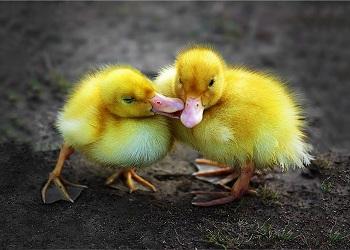

Don't forget to vaccinate your birds. This will help you not only to save as many birds as possible, but also to protect yourself from some parasites that can settle in the body of ducks.
Duck breeding is very popular because it gives good results, is quite profitable and not too expensive.
How to breed ducks at home: content
- Bacitracin. Used to destroy Kokka sticks, anthrax sticks. Add 1kg per 100kg of feed. Apply to birds from 1 day and older.
- Grizin. General antibacterial effect, universal preparation. 1kg is added per 100kg of feed, the best time is 1-2 weeks old.
Antibiotics will help prevent diseases when the bird's immunity is just forming.
In the form of feed, it is best to use corn grits, fines from grain, millet, finely crushed vegetables and greens. It is important to give feed additives to babies up to 2-3 weeks of age, then the profitability will decrease significantly.
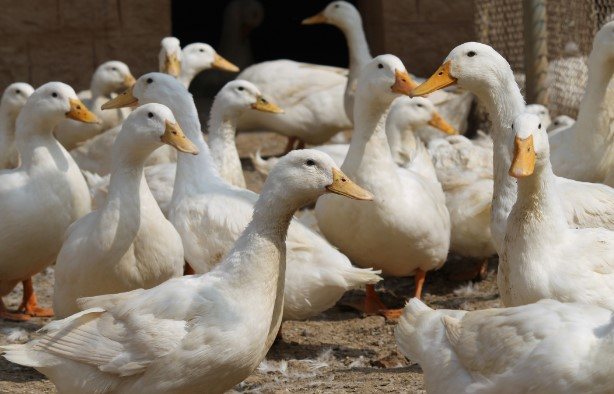

For a proper diet, it is necessary to feed the babies up to 5 times a day, the bird should eat up to 5-8% of its body weight. Those. for 100 individuals up to 1 week old, it is necessary to consume about 5-7 kg of feed per day. You can purchase starter food for ducklings up to 1 week, after which you can gradually switch to regular food. As a percentage, it is necessary to give to ducks:
- animal and vegetable proteins - 15% of the feed weight;
- grain-flour feed - 45% of the feed weight;
- root vegetables and greens - 20% of the total diet;
- baker's or brewer's yeast - 3% by weight of feed;
- fish oil - 1.5%;
- hay flour - 5%.
Approximately this proportion of feed is optimal and should be adhered to throughout the entire period of feeding the ducks. When the required weight of the duck is reached, it will be better to increase the portion of grain-flour feed for a greater set of meat and fat content of the poultry.
Temperature conditions.
The duck is a very thermophilic animal. Chicks up to 1 week should be kept at a temperature of 28-30C, after 5-7 days of keeping it can be lowered to 25C, then. When the individuals have good plumage (2-3 weeks), the temperature drops to 18-20C and is maintained until the bird is fully ripe.You can use any heaters, but infrared ones are better, so that the heating is deep and without a draft.


Duck feeder made of plastic sewer pipe
Ducks need a lot of water, so getting a drinker is a top priority. We consume 0.5-0.7 liters of water per day. Drinking bowls can be built by yourself or purchased at the store. The simplest and most inexpensive option is a vacuum drinker, which is a special plate into which an inverted three-liter jar is inserted. Ducks' water should always be clean and fresh.
Another essential element of a poultry house is nests. They are quite simple to make with your own hands. To begin with, a frame is made, which is then sheathed with boards. One cell should be about 40 x 40 or 50 by 50 cm in size. The nests should be set at a distance of about 50-60 cm from the ground. Before entering the cell, a sill should be installed so that birds can easily climb in and out of the nest. Three ducks need one slot, so if you have 15 ducks you need nests with five slots.
In a private courtyard, it is easy to build a small pond yourself by digging a hole in the ground and filling it with concrete. If there is any container, then it can be dug into the ground to such a level that the bird can easily access the water. You can make a pool for ducks from old car tires. It is advisable to find a tire from a truck or tractor, cut it lengthwise into two parts and fill it with water. This will create two containers of water.
Breeding ducks. Incubation and brood hens
The reservoir serves as an excellent stimulator for active mating of individuals. But you can do without it by providing the ducks with a basin of water. For one male, there should be about ten females. As a rule, with proper care, or rather with good feeding, ducks begin to lay eggs when they reach mature and reproductive age. This happens at about six months of age, and sometimes even earlier. Each duck egg weighs approximately 50 to 60 grams. To incubate duck eggs, you can use both an incubator and hens, but not only ducks. Chickens and turkeys and geese will do. We select eggs with a dense, clean shell without cracks, according to the shelf life of no more than a week.
Duck eggs incubation lasts about 28 days. For incubation, you can use both electronic factory and homemade incubators. The main thing is to maintain the correct incubation regime. The first two weeks the temperature should be about 38 degrees, after which it should be kept at around 37.8 degrees. Ducklings, after hatching, need sensitive care for the first two weeks. We feed them in the same way as chickens, for the first five days a boiled egg, steamed millet, weak tea leaves. We do not allow their hypothermia and do not let them into the reservoir for the first two weeks.


Can hatch duck eggs and hen hen. There were cases when a hen continued to lead her unusual offspring, until the very stage of plumage. You need to store duck eggs intended for incubation in a cool, dark place, in a basket with sawdust, no more than a week. Before setting in the incubator, heavily soiled eggs are washed with running warm water and wiped dry, avoiding sharp shaking.
Moscow white
The breed was developed by Russian scientists in the Moscow region. The result of their work was a meat duck, which also has excellent egg production.


Moscow white
The appearance of the Moscow white birds is similar to the Peking ducks. But they have a number of distinctive features:
- The constitution of birds is massive, the sternum is wide, expanded.
- The head is small in size, adjacent to the fragile neck, and the beak has a bright red color.
- The limbs are short, and their color is pink. The weight of the male is 4 kg, and the female is 3 kg.
- The breed differs in eye color - blue.
The advantages of the breed include:
- For a year, a duck is capable of producing 130 eggs, the mass of one will be 100 g.
- Low cost of poultry.
- Not exacting care.
- Females are ready for sexual activity in six months.
- High survival rate.
- Lean and tasty meat.
How to raise chicks
In order for the ducklings to be strong and healthy and gain weight quickly, in addition to proper nutrition, it is necessary to create comfortable living conditions for them. To do this, you need to equip the poultry house and make a pasture for walking.
Arrangement of premises


Light bulbs with a capacity of 60 watts work well and should be hung in the house at a height of about two meters. One square meter of the room requires 5 watts of power, using this formula it is easy to calculate the required number of lamps.
It is also necessary to arrange a deep bedding. It is this method of floor preparation that is usually used when raising ducklings in a household environment, while in poultry farms, a mesh floor is used. To create it, you can use:
- wood shavings;
- straw;
- crushed corn rods.
First, lime fluff is poured onto the floor in the amount of 600 grams per 1 square meter, after which the litter is laid, the thickness of which should be at least 6 centimeters.
To feed the ducklings food, it is convenient to use trough feeders. If trays are used for this, the bird will trample the feed, making it unusable.
How to make a drinker for ducklings with your own hands
The bird should always have access to drinking water, so, last but not least, you need to take care of a good drinker. It can be made from a plastic plumbing pipe of a suitable diameter. This requires:
- cut rectangular holes along the entire length of the pipe;
- close one end of the pipe with a plug;
- on the other end, install a plastic elbow with a 90-degree angle.
At this, the drinking bowl is ready, it remains only to fix it motionless so that the hole of the plastic elbow looks up - fresh water will be poured through it. To install the drinker in the pasture, it is enough to stick four wooden or metal rods into the ground.
Pasture
In addition to the poultry house for the ducklings, it is necessary to prepare a good pasture. For this, the area on the south side of the farm, which receives the most light, is best suited. It must be fenced off with a net and divided into several sections.
It is good if there is a reservoir on this territory, in this case the ducklings will independently find up to 50% of the food in it, and this will significantly reduce costs.
Incubator, young or adult?
There are three ways to start breeding ducks. The first is to buy a hatching egg. This requires an incubator and knowledge of this process. It should be borne in mind that there is a certain risk when hatching in an incubator and if you have little experience, then first carefully study this issue.
Buying young animals is a fancier way, but also more expensive. Choose healthy ducklings from one week old. Young animals will need special care and feed. You can find detailed information on the pages of our magazine.
The third way is the acquisition of adults. It has a number of advantages, including:
- Minimal risk of death;
- Faster growth and production of products (meat, eggs);
- An adult bird does not need any special feed.
The only negative is the higher financial costs. By the way, if you don't want to make a mistake with the purchase and want to purchase a healthy, productive bird, then it is better to contact a person who has come across the purchase of ducks. Or in detail and without haste to study this issue on the website Ptitsevodu.ru.
An adult duck (drake), depending on the breed, can weigh from three to four kilograms. The most common breeds of meat duck breeds.
- Beijing: growing and gaining weight quickly, tolerates winter well. Two-month-old young animals have a live weight of about 2.5 kg. An adult duck - up to 3.5 kg, and a drake - up to 4 kg. Egg production - up to 110 eggs per year. The meat is delicious.
- Bashkir colored: meat of excellent quality, adapts well to new conditions of keeping, low fat content. Productivity is high.
- Black white-breasted: the weight of an adult duck is 3-3.5 kg, a drake is up to 4 kg. The meat is delicious. A distinctive feature of this breed is increased egg production - up to 130-140 eggs per year.
- Moscow White: the same weight as the black white-breasted. The meat is very tender and tasty. Egg production is high - up to 160 pieces per year.
- Gray Ukrainian: live weight of drakes is 3-3.5 kg. Weft - up to 3 kg. Egg production is very high and sometimes reaches 220 pieces per year.
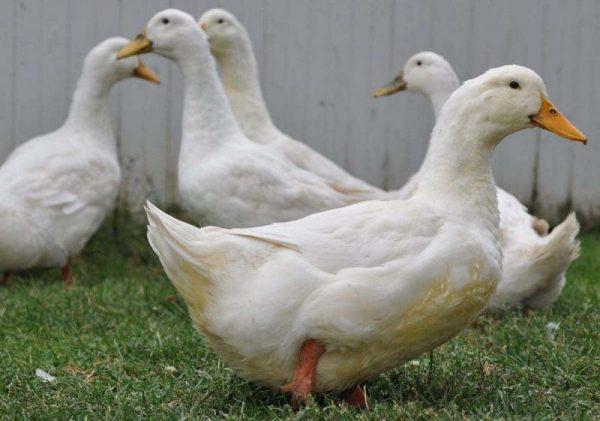

Among the meat, egg and egg breeds, the following can be noted.
- Khaki Campbell is a meat and egg breed of ducks. Differs in a calm character. Average egg weight - 75 g, egg production - up to 330 pieces. Drake weight - up to 3 kg, ducks - up to 2.5 kg.
- The Indian runner is an egg breed. It got its name from its high mobility. Egg production and weight are similar to Khaki-Campbell. The meat tastes like chicken.
To decide on the choice of the breed, you need to decide for yourself for what purposes you undertake to breed them. Meat breeds weigh more, egg production is less, in meat-egg and egg breeds - on the contrary. White and French ducks are also good for growing.
The ducks are kept indoors or outdoors. In the first case, they should feed more intensively due to compound feed and low mobility of the bird.
The room should be well ventilated, moderately light and warm. An adult duck tolerates winter well, but it is better that the indoor temperature during this period does not drop below 5 degrees Celsius. For 1 sq. m of the area are bred 4 ducks.
Walking way for this bird is better. But it depends on the ability to do such a walk and the presence of a reservoir. In this case, it is better to split the livestock into small groups - 10-15 heads each, dividing them with low partitions. Of the reservoirs, shallow rivers and lakes are preferred. The walks are fenced off with a low fence.


Adult ducks on a walk by the pond
The feed is the same as for the young. Emphasis is placed on the grains of cereals and corn, with more corn in the composition. Do not give ducks bread crumb, which negatively affects the digestive system of the bird.
It is also forbidden to give not fresh mash. In general, if there is a suspicion about the quality of the feed, it is better to refrain from feeding it to the bird. Do not forget to give green mass or release it for walking in the pasture, if there is no reservoir nearby. If there are nearby rates or a lake - drive them there. On it, ducks will find the bulk of their food.
- 40% of rubbing a mixture of grain crops, of which at least half is corn;
- 30% green mass;
- 10% grain waste;
- 7% cake and meal;
- 7% animal feed;
- 6% shells, chalk, feed yeast, vitamins, mineral supplements, etc.
- from birth to 7 days old, ducklings are fed with starter concentrates.For 20 heads, 32 kg will be required;
- then the young are transferred to a mixture for adolescence. It is necessary to prepare 124 kg for 20 heads. Feeding lasts 6 weeks;
- the last month they use finishing feed. They will be required for a livestock of 34 kg.
It is very important to give vitamins to ducklings and adult ducks, especially in the autumn-winter and winter-spring periods, when there is not enough sunlight and there is no greenery at all. If it is problematic to buy vitamins, you can use brewer's yeast, which contains a lot of proteins, carbohydrates and fiber.
Breeding ducks is no big deal. The main thing at the initial stage of their cultivation is to be attentive to the feeding processes, to give balanced food and to find a place for them to walk and a reservoir for them. Then not only will your family have tender and tasty meat, but you will also be able to cover the costs of keeping this bird with interest by selling surplus products.
For fattening ducks of meat productivity, combined dry feed or traditional nutrition with grain mixtures, vegetables and green grass is used. It is more efficient, but expensive, to use concentrates than cereal mixtures. For targeted feeding, the birds are kept in cages. After 2 months, the young are used for meat. From each individual, you can get up to 4 kg:
Concentrated mixtures are balanced in terms of nutrients and minerals, as well as vitamin supplements. Additionally, you do not need to purchase premixes, give chalk and gravel. The starting mixes are finely ground. Food for teenagers is also crushed, but not into flour. It is produced in the form of small granules. For finishing feeding, feed in granules, coarse grain is used.
| № | Helpful information |
| 1 | 26% - corn grain; 83.3 kg |
| 2 | 15% - bran; 46.6 kg |
| 3 | 12% - barley; 36.6 kg |
| 4 | 10.2% - wheat; 30 Kg |
| 5 | 10% - cake; 31.6 kg |
| 6 | 6% - soybean meal; 20 Kg |
| 7 | 5% - peas; 13.3 kg |
| 8 | 5% herbal flour; 16.6 kg |
| 9 | 3% - fish meal; 10 Kg |
| 10 | shell, chalk - 8 g per head |
| 11 | salt 1 g per head |
More on the topic:
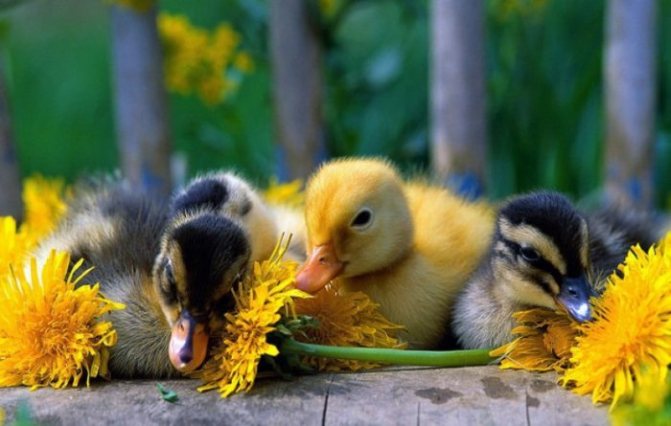

Why do ducks fall to their feet?
The ration is designed for 20 animals. For the feeding period 2 months. All ingredients are mixed, stored in a cool and dry place. Barrels made of plastic or stainless steel are used as containers. The barrels must be closed so that moisture, insects and rodents do not get into the feed. Some of the feed can be replaced with vegetables.
For the first week, the chicks are fed every 3 hours. In the future, the ducklings are transferred to 3 meals a day. This regime is maintained until the end of fattening. The cereal mixtures are divided into 3 equal parts. When using succulent forages such as grasses and vegetables, reduce the feed of the grain mixtures. In the morning, the ducks are given chopped hay and succulent grass. At lunchtime and in the evening they are fed grain.
A separate extension is allocated for breeding birds. Particular attention should be paid to nests - the number is equal to the number of females. The nests are made in the form of boxes made of wooden planks with a covered bottom and are located on the farthest side of the section.
- incubation (natural way);
- incubation (artificial method).
To grow offspring by the natural method, you need a separate nook, equipped according to all the rules:
- Nests for hatching chicks must be covered with sawdust or hay. From time to time, the contaminated layer must be removed and dry material should be reported from above.
- Maintaining the correct temperature regime will ensure a good percentage of hatching of chicks and their further vitality.
- The increased 20-hour daylight hours increase the productivity of breeding ducks, as the ducklings grow, it is gradually reduced to the standard 14-16 hours.
- In terms of overall dimensions, the room needs the same as for young animals, only smaller in area. For adults, the space is calculated as follows: one sq. m. for one duck.
The survival rate of chicks with natural incubation is 90-95%. The period from the beginning of hatching to hatching is 30-35 days. Accordingly, the average duck is able to hatch 2 offspring. A breeding female can hatch up to 15 eggs at a time.
With the artificial method, the survival rate is much lower - only 60-70%. Incubators are convenient for their large capacity and built-in heat regulator and timer. Intervention on the part of the owner is still required - you need to turn the eggs at least 4 times a day.
Raising ducklings for meat
Raising ducklings for meat should take place in excellent temperature conditions, there should be enough light and a correct feeding diet. Raising ducklings for meat, as a rule, takes no more than two months. This is due to the fact that up to two months, domestic ducks grow as quickly as possible and gain weight, and after this time they begin seasonal molt and they stop growing in weight, or even lose it altogether. Therefore, it is so important to select before this time to select the ducklings for the tribe, and for meat.
Ducklings that are raised for meat should be kept warm within 3 weeks from birth.It is advisable not to allow the temperature to drop below 22 degrees. Daylight hours should also not be reduced, and the light intensity should be approximately 2-3 watts per 1 sq. M.
The diet for feeding ducklings raised for meat is significantly different, rather it resembles feeding ducks, therefore it is necessary to maintain this particular diet.
Broiler ducklings are specially raised for meat. Broilers are meat breeds of ducks.
ferma-
Indian runner
This species of ducks is still young and new, because it was bred only 100 years ago. Not so long ago, the Indian runner was considered an ornamental breed, and you could see him at the zoo. But today this bird increasingly began to appear in the household.
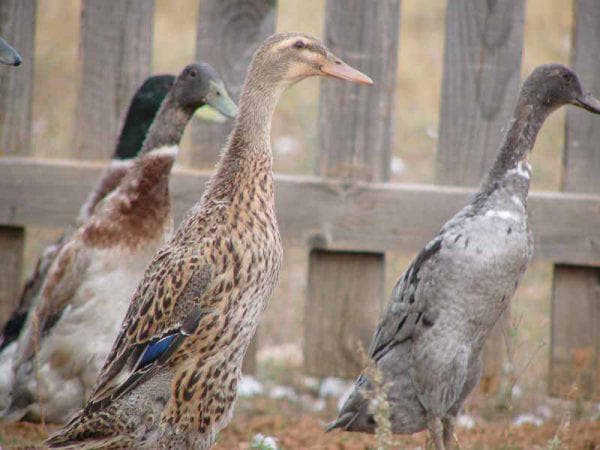

Indian runner
You can recognize the breed by the following features:
- Straight torso. When the bird walks, its appearance is comparable to that of a bottle.
- The color of the feathers can be very different - white, dark brown, blue and even blue.
- The neck is long, as are the limbs, which makes the ducks move quickly.
- The female weighs 1.7 kg, and the drake 2 kg.
- A duck can produce 200 eggs per year. The appearance of an egg is very similar to that of a chicken in color and shape.
- And although this breed belongs to eggs, its meat can also be eaten.
The advantages for runners include:
- Actively move and move around the yard.
- A high degree of cleanliness of the bird requires infrequent cleaning in the house.
- Record egg production.
- Birds quickly acclimatize to different weather conditions.
- The female and male are excellent parents who never abandon their ducklings.
But what Indo-women eat at home, and how to breed them correctly, is laid down here in the article.
There was no drawback in this breed, although there are some birds that are too dependent on water. If they have limited access to it, then it will adversely affect its egg production.
Some features of ducks
The body of the ducks is completely covered with oily feathers, so water cannot penetrate under the layer of fluff and wet it, thus it is very difficult to drown the duck. Ducks have a sufficient amount of adipose tissue, which helps to provide the feathers with lubricating fat and thus prevents hypothermia. Therefore, ducks are excellent divers and swimmers, and even after several hours in the water, their feathers remain completely dry.
Ducks feel comfortable even in freezing temperatures, thanks to their plumage. The legs are also a great feature of the ducks. The structure of duck paws is distinguished by the presence of three fingers and membranes between them, like all waterfowl. Their paws help ducks move quickly along the lake surface, and their claws help them defend themselves from enemies and move steadily over land. The beak of a duck has an orange and less often brown or yellow tint, it is more powerful than a chicken one, so a duck is able to crush the shell of a snail shell, or kill a frog or fish.


Unlike chickens, which lay chaotically, during daylight hours, ducks lay either early in the morning or late in the evening, so you should not release ducks too early for walking, you simply cannot find eggs later. Ducks are gluttonous, and are able to eat anything that attracts their attention, so do not leave nails or coins in the yard, clean, and do not let dangerous things get into the bird's stomach. There were cases when in the stomach of a bird they even found precious jewelry and coins lost by their owners, as well as small screws and nuts. As a rule, properly accustomed ducks, to their yard, rarely leave, or get lost, ducks are quite intelligent birds and are well oriented on the terrain.
Preparing the room
Any breed of ducks needs proper maintenance and care. The poultry house should be warm, dry, and free of drafts. To begin with, you can prepare an old barn or build a new house if possible.
A room with ducks should receive natural light, so a window is required. It is even better if this window opens and closes so that it is possible to ventilate the house. In summer, the room should not be too hot, and too cold in winter. The minimum temperature in winter is 5 degrees Celsius.
Ducks should not be kept only in a barn; in summer, they must be given the opportunity to walk in the fresh air. To do this, you can attach a special paddock to the poultry house, upholstered with a net. In this case, the bird should have free access to the barn and back.
Necessary equipment, arrangement of the poultry house and places for walking


The conditions of keeping are reflected in the egg production and weight of the birds.
Depending on the number of individuals, the purpose of breeding determines the type of structure:
- Capital building. It is erected on a strip foundation, of bricks or blocks. Suitable for year-round use.
- Frame house made of wood, plastic panels and other lightweight materials. Suitable for living in the warm season.
The conditions of keeping are reflected in the egg production and weight of the birds.
Rules for arranging a room for growing ducks:
- The size of the building is calculated by the formula: for one duck - not less than 0.6 m2. The minimum threshold is 1m2 per 3 individuals. It is not recommended to erect a building with an area of less than 16 m2: excessive crowding will lead to a lack of fresh air, provoke conflicts between individuals.
- Organization of convenient nests in the form of wooden boxes.
- Temperature not lower than +5 0С, humidity from 65%, sufficient illumination. Window openings make up at least 10% of the wall area.
- The presence of a vestibule, which will prevent the penetration of cold air from the street in winter.
- Organization of manholes for the exit (it is better to make several pieces), window openings are equipped on the south side of the building.


Be sure to read:
How to build a house for a duck with your own hands: designs and step-by-step instructions
If there is no natural reservoir nearby, you will need to make a small artificial reservoir. With a small number of ducks, an old bathtub deepened into the ground is suitable as a water tank.
Litter
Properly organized bedding prevents the spread of pathogens and helps maintain the temperature within the required range.
It is built from materials that absorb moisture:
- straw;
- sawdust;
- peat;
- moss.
The thickness of the litter should not be less than 10 centimeters. They constantly monitor its purity and renew the top layer as it gets dirty.
Walking area
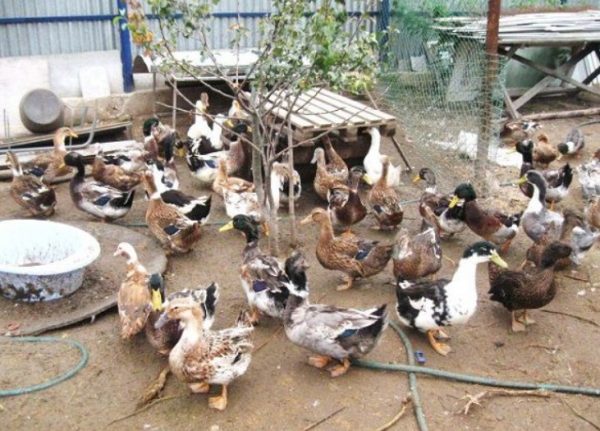

The walking area is fenced off
The walking area is fenced off. In order for an individual of a meat breed to gain weight quickly, the optimal density of birds during walking should be 1 m2 for 5-6 individuals.
In some farms where birds are raised for meat, ducks are walked in special cages where they cannot actively move.
Along the edges, it is necessary to install feeders, drinkers. The feeder is made elongated and narrow, with high sides, since birds can climb into the feeder, scatter food. In hot weather, each duck drinks at least 1 liter of water, which needs to be changed several times a day.
Khaki Campbell
When breeding this breed, the breeders set themselves the goal of getting a bird that would not only lay eggs well, but also have a meat orientation. The English breeder managed to translate this into reality, after whom the duck was named.
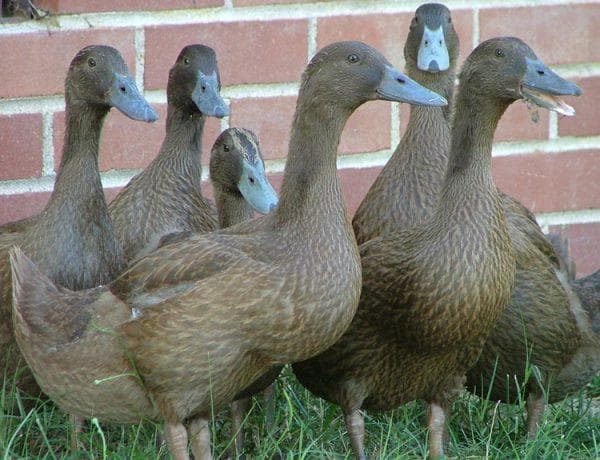

Khaki Campbell
You can recognize Khaki Campbell by the following features:
- Feathers can be of different colors - from light brown to light white.
- Male weight - 3.6 kg, female - 2.5 kg.
- The breed belongs to the early maturing, since after six months the female is ready for mating.
- A duck can produce 200-250 eggs per year. The mass of one will be 80 g.
- The head of the birds is small, like the beak with the neck.
The advantages of the Khaki breed include:
- High egg production.
- Duck meat is tender and tasty.
- Birds quickly acclimatize to new conditions.
The Khaki Campbell breed has one drawback - females are not able to hatch eggs for a long time, so if a person does not intervene, then part of the droppings may die.
Chick feeding rules
When growing duck young, feeding is normalized according to three age groups:
- up to 10 days;
- from 10 days to 1 month;
- after 1 month.
Feeding ducklings in the first 10 days
In the first days of life, hatched chicks need to be fed often - every two hours... The first serving can be given as soon as the babies are dry. As feed for chicks up to one and a half weeks old, use:
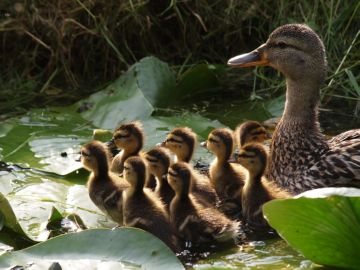

- finely chopped hard-boiled eggs - they can be given from the first day;
- greens and wet mash, which are added from the third day of life;
- from the fourth to fifth day, you can include animal products and mineral supplements in the diet of ducklings - low-fat cottage cheese, milk, meat and fish meal, chalk and shell.
For the manufacture of wet mash for fattening ducklings in the first 10 days of life, it is better to use corn, ground cereal grains, oilcakes and bran.
Diet of ducklings aged 10 days to 1 month
At this time, the nutrition of the young should provide him with good health and activate the growth processes. Here is an example of a balanced diet for ducklings under 1 month of age:
- corn - about 50%;
- waste from sunflower processing - 20%;
- wheat - about 13%;
- fish meal - 7%;
- feed yeast - about 5%;
- herbal flour - 4%;
- feed fat - 0.5%;
- feed chalk 0.5%.
After 1 month
After reaching the age of 1 month, it is necessary to ensure rapid weight gain. Based on this, a diet is selected, for feeding you can use the following formula:
- corn - 45%;
- cake - 17%;
- wheat - 13%;
- barley - 8%;
- feed yeast - 5%;
- fish meal - 4%;
- feed fat - 1.5%;
- meat and bone meal - 1.5%.
It is very important that ducklings at this age spend a lot of time in the pasture, where they will nibble fresh greens.
Raising ducks at home: feeding and keeping
- Wheat;
- Oats;
- Millet;
- Corn;
- Barley;
- Fish and dairy products;
- Vegetables and fruits;
You can feed the ducks with compound feed, which is presented in a wide range in specialized stores. If you breed ducks for meat at home, for example, in the country, then there should be no problems with food. After all, poultry is usually grown in the summer, when there is plenty of green grass, various vegetables, plants, etc.
For two months of maintenance, approximately 6 kg of hay or cloth flooring is required per adult duck. Litter is needed only in the cold season, in summer you can do without it.
The frame of the building is made of wood or cinder block. Care must be taken to ensure that the room is adequately ventilated and the walls are insulated. The presence of gaps is not allowed, the house should be sheltered from all sides from strong winds and dampness. Proper lighting and heating, with the help of additional equipment, are also key principles for keeping ducks.
What breed of domestic ducks to choose
At the moment, there are many breeds of ducks that are suitable for a variety of conditions. And each poultry farmer needs to choose the bird that suits him the most. This is not an easy task, since each species has its own advantages and disadvantages, so when choosing a breed, it is worth deciding what is required of the birds in the first place. The owner must understand why he will breed this breed and in what conditions the breeding will take place.
Breeding ducks at home will not be difficult with the right variety. The first thing to understand is that there are three areas of production, which include all breeds of these birds. This is the meat, meat and egg production line. Egg eggs should be ignored right away: these ducks fly no better than chickens, but are inferior to them in weight.You should choose from the meat and meat-and-meat directions. It should be understood that there are many breeds of both types.
Meat production
Most poultry farmers prefer to settle on this type of domestic ducks. They are able to quickly gain weight and you can get a lot of delicious meat from them. And some breeds are distinguished by decent egg production. Of these varieties, it is worth noting the gray Ukrainian duck and the black white-breasted bird. Still good layers are obtained from representatives of the Moscow White breed. Among the purely meat varieties, there are also many worthy candidates for growing.
For those who are interested in raising ducks for meat, the Peking breed or Indo-duck is usually recommended. The Peking breed is good at gaining weight, and their meat is high in fat. These birds are distinguished by their unpretentiousness and early maturity. They are also used when breeding other breeds, which are also worth paying attention to. From Peking ducks, in particular, Bashkir birds and blue favorites were bred. Some poultry farmers prefer to breed these particular waterfowl.
Muscovy ducks deserve a special mention. They are not as fatty meat as the Peking variety, but they also gain weight very quickly. They have an average egg production, but the queens of this breed are distinguished by a developed instinct for breeding offspring. Among the shortcomings, it is worth mentioning the fact that Indo-women do not tolerate low temperatures. For them, it is necessary to separately insulate the room. When crossed with other breeds, they give hybrids that are not capable of reproduction, but unpretentious, early maturing and with tasty meat.
Meat production
Ducks of this type are recommended for novice breeders who want to receive not only meat, but also eggs. When breeding at home, when the egg is needed only for their own consumption, these birds are ideal. They are able to gain weight quite briskly, but at the same time they bring a sufficient number of eggs. It is worth considering that the varieties of the meat type are more popular than those related to the meat type. All due to the fact that the meat type is more profitable for industrial breeding.
But for small farms, meat ducks are great. Among such breeds, it should be noted the mirror variety, the Saxon and Cayuga. The most common in Russia and Ukraine are mirror ducks. But many poultry farmers recommend breeding birds of the Cayuga species: they gain weight well, have good egg production and are able to live in cold regions. And they also have a well-developed maternal instinct, therefore, if you draw up a plan for breeding ducks in the north, you should pay attention to this particular variety.
Mute
This breed is great for seasonal growing. The meat is distinguished by its high taste. For 2.5 months, the duck gains 3.6 kg. Two birds can be raised in one summer. Their content is simple and does not cause much trouble. They are quiet and clean.


Mute
Birds are picky about food. Wet food is great for them. It can be steamed compound feed, grain or bran. Grass should also be present in their diet. Nettles, tops, and grass are great.
Duck diet
Ducks are almost an omnivorous bird, in addition, they are able to feed themselves on reservoirs. The diet of ducklings is no different from that of chickens. It is necessary to add meat and bone meal to the diet of ducks, you can collect snails in the garden, May beetles, this bird does not disdain anything. In order for ducks to grow and develop well, it is necessary to diversify their diet with nutritious food, in accordance with the food consumption rates of individual breeds and their growth rates. If the ducks are kept locked up, then in addition to the increased nutritional value of the feed base, you need to add vitamins and minerals to the diet.
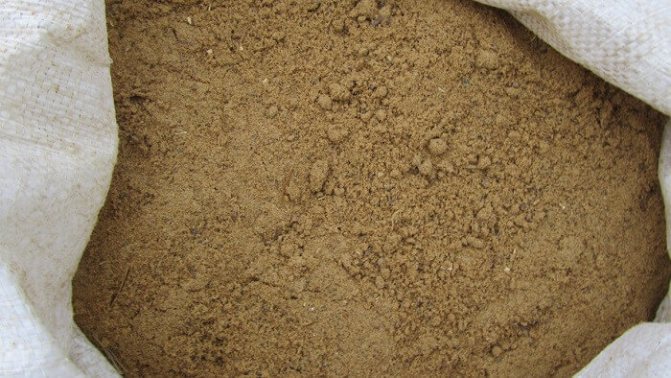

If you want to achieve the proper quality of duck products and a high yield of the meat component, as well as high egg production, then ducks must be provided with a sufficient amount of feed, and fed twice in the morning and in the evening, a well-balanced and nutritious food. You can use mash and bran, with an admixture of fortified additives, give boiled and fresh chopped root vegetables and peel. Do not forget about the gluttony of ducks, do not overfeed, but do not starve, achieve the optimal ratio. For example, an adult duck should eat at least four hundred grams of feed per day, of which about half of what is eaten is given to grain.
Cayuga
This breed was bred in America. Birds appeared on the territory of Russia not so long ago, but they have already managed to gain fame. You can distinguish between breeds by the following features:
- Unusual feather color. Most often it is blue and has numerous overflows.
- Birds have a strong constitution. The color of the eyes is brown, the beak and limbs are black.
- The legs are short, and the tail is slightly lifted up. The male weighs 3.8 kg, and the female weighs 3 kg.
- In one year, a duck can bring 130 eggs, and the weight of one will be 70 g. The color of the shell is immediately black, and then it changes to gray and green.
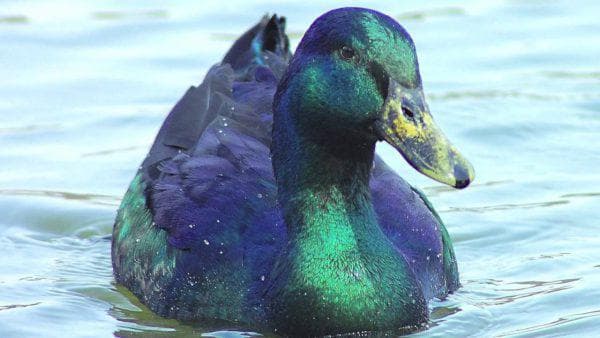

Cayuga
- Females have a well-developed maternal instinct. They do not drop eggs or their chicks after they are born.
- Representatives of the breed are well acclimatized to new weather conditions.
- The duck has a calm nature.
- Birds love to walk outside for a long time.
- High survival rate.
Raising ducklings
From the very birth of ducklings, it is necessary to determine for yourself the goals of raising ducklings. If you want to get the maximum amount of meat from the ducklings, at the lowest cost, then you need to start from some growing factors, and if the main goal is to get the next healthy generation of ducklings and get eggs, then the technique will be completely different. However, we will return to this later, and at the beginning I would like to talk in detail about the general factors affecting the safe rearing of ducklings at home. Namely: about the conditions of keeping, sorting of day-old ducklings, as well as about other equally important aspects of raising young animals.
As a rule, ducklings are born at home in early April - late September. However, if you want to get a large livestock, and as a result, maximum productivity, then it is more expedient to raise ducklings in three stages. The first stage is in early April. Ducklings bred in April can be used for breeding, or you can get meat by the beginning of June. The second stage is at the beginning of July. You can also leave these ducklings for the tribe or get meat by September. The third stage is at the end of September. It is not advisable to leave these ducklings for the breeding in the winter, such young animals can be slaughtered by the winter.
Gray Ukrainian
These ducks are also popular among domestic breeds. They are distinguished by their strong constitution and the presence of dense plumage. The head of the birds is medium in size, but the beak is quite massive and has a dark yellow color. Birds gain weight and grow very quickly.
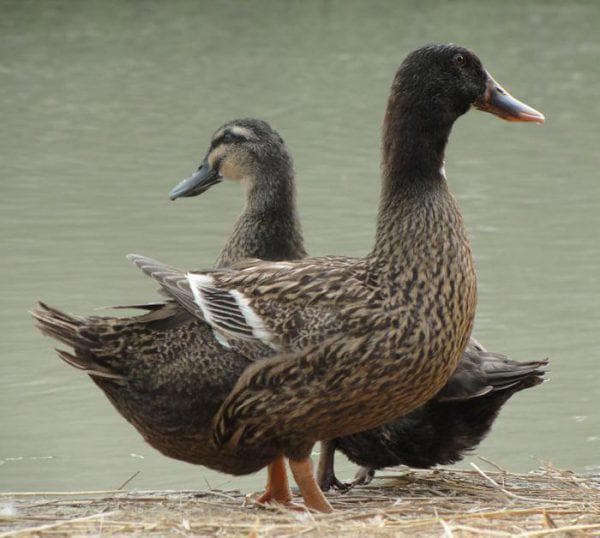

Gray Ukrainian
Already a mature individual has a body weight of 3 kg, but a male - 3.5 kg. Also, the breed has a high egg production. 120 eggs can be obtained from one individual per year. But if you provide ducks with proper care and nutrition, then egg production will increase to 250 eggs per year. But what the Ukrainian black breed of chickens looks like, as well as how it is bred at home, is described here in the article.
Ducks today are among the most popular types of birds for the household. They grow quickly and gain weight, do not require increased attention to themselves, while they are capable of high egg production and give tasty meat. When choosing a suitable breed for yourself, it is necessary to take into account the living conditions of the bird, its orientation and resistance to diseases.
Correct feeding
Correct, balanced feeding of ducklings is perhaps the most important factor when raising ducks at home.
Duck offspring should be fed immediately, as soon as the chicks are dry. Up to five days, young animals are often fed (about once every two hours). Ducklings are given hard-boiled, finely chopped eggs mixed with crushed millet, oat or barley grains.
When breeding and raising ducklings for meat, fresh greens must be present in the feeding troughs of young animals: nettle, clover, dandelion, etc. Wheat bran is a good food for chicks.
An approximate diet for little ducklings:
- ground grain;
- wheat bran;
- various legumes;
- cake;
- greens;
- vitamin supplements;
- shell or chalk;
- salt.
It is good to add potassium permanganate to drinking water. The diet of young animals should contain grain feed, cereals, a variety of protein foods, such as eggs and cottage cheese.
Starting from the age of one month, young animals are transferred to three feeding times. You can add food waste and potato, beet or carrot tops to your regular diet. Ducklings intended for the tribe are released into the pasture.

